In my last post, I talked about what the island of Tinian was like in World War II, when it served as the launching point for strategic bombing raids on Japan — including the bombings of Hiroshima and Nagasaki.
A physicist friend of mine from graduate school, Alex Boxer (who currently consults the Navy about submarines, and has his own history of science blog), recently took a vacation to Tinian, and took a ton of photographs. He’s given me permission to re-print some of them here, along with some of his comments on them (which are in italics).
You can begin your virtual tour of Tinian with this movie of what it’s like to fly there from Saipan. The planes are just little 6-seater prop-planes, and the flight is probably a grand total of 10 minutes. In this movie (sped-up 2x to reduce its size) you can see the whole island and what’s left of the North Field runways.
There’s very little to see that’s bomb-related — it’s striking, really, it’s almost as if the US military was never there. The only buildings which remain from that era are Japanese installations.
A random Japanese propeller located on the southern end of the island:
At North Field (located, sensibly enough, at the North end of the island) there are several Japanese buildings:
Description from a placard outside the building:
This two-story building was the World War II headquarters of the Japanese Navy’s 1st Air Fleet (Base Air Force of the Marianas), commanded by Vice Admiral Kakuji Kakuta. … Admiral Kakuta’s airfields in the Marianas and Iwo Jima served as staging areas for moving aircraft to southern Pacific battle areas and for attacks on American ships. By July of 1944, the airfields directed from the 1st Fleet headquarters had been captured or destroyed. What remained of Admiral Kakuta’s airplanes was destroyed in the naval battle of the Philippine Sea a month before the battle of Tinian. … When Americans captured Ushi Field, the headquarters building was abandoned and Ushi Field was a “ghost field” of abandoned airplane wrecks. The fate of Vice Admiral Kakuta is unknown, but was probably suicide or death. His last radio message to Tokyo was on July 30 as the battle of Tinian was nearing its conclusion. The massive concrete headquarters building was damaged by American artillery, but the building was repaired and used by American military officers after the invasion.
Another placard:
This building was the control center for the Japanese Navy’s 1st Air Fleet operations on Tinian, directing traffic on the runway to the south. It contained an office, the operations room, and a generator room. This is a standard design for World War II Japanese air operations buildings, with other examples located on Saipan and Chuuk. … The building was repaired and used as a control tower by the 20th Air Force after the B-29 runways of North Field were constructed here.
One more placard:
This massive power plant was probably build in 1939-1940 as part of the Japanese military construction of Ushi Field. the “bombproof” building was constructed of reinforced concrete and had steel shutters covering the windows. The building housed a 200 kilowatt power plant run by diesel fuel.
And here’s what you’ve been waiting for: bomb-pits! — The pits where Little Boy and Fat Man were loaded into the B-29s that dropped them on Japan.
I was somewhat dismayed at how little there was to see. It’s just two pits now under glass enclosures, somewhat like the entrance to the Louvre. The glass was also highly reflective which means that most of my photos didn’t come out very well.
Tinian was fantastic because it was one of the emptiest and quietest places I’ve ever been. I felt like I had the whole place to myself. However, there is nominally a tourist industry there which includes a rather shady hotel/casino. The tourists are mainly from Asia and Russia — there’s hardly anyone from the mainland US (a brief look at a map of the Pacific will make it clear why this is so). Anyways, our silent day was enlivened by a large tour-bus. I’m certain that these tourists are not Japanese; I’m almost, but not quite 100% certain that they are Chinese.
Interjection: just to compare, here are the actual loadings of Little Boy and a Fat Man test unit.
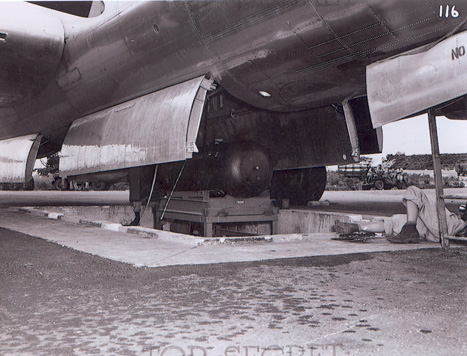
Or you could fly all the way to Tinian, and see the same sort of photos in the actual bomb pit:
Back to Boxer:
And as much as I’m an aficionado of atomic (or, rather, nuclear?) history, that wasn’t the main lure for me. Here’s what I really wanted to see on Tinian:
These are parts of the House of Taga:
The site is the location of a series of prehistoric latte stone pillars which were quarried about 4,000 feet south of it. Only one pillar is left standing erect. The name is derived from a mythological chief named Taga, who is said to have erected the pillars as a foundation for his own house. Legend says Chief Taga was murdered by his daughter, and her spirit is imprisoned in the lone standing megalith at the site.
I have to admit, I wasn’t aware that the only other tourist site on Tinian was just about as grim at the first atomic bomb loading pits.
And, just for fun, here’s a lovely photo of a Flame Tree:
Very cool. Let’s all give a little round of virtual applause for Dr. Boxer and maybe visit his website while we’re at it.
Now, you might be thinking — well, Tinian’s heyday has come and gone. And you might be right. But there’s been some interesting news about it from earlier this year:
Japan Self-Defense Forces officials will arrive today to discuss with CNMI officials their plans for Tinian where two-thirds of land are already leased by the U.S. Department of Defense, and the discussions could center around Japan’s plan to help fund a U.S. military base on Tinian or the training or stationing of their own forces there.
That’s right — there’s a chance (perhaps not a great one) that Tinian might yet be the site of a military base. What would be more appropriate — or inappropriate? — than Tinian becoming a joint US-Japanese military site?
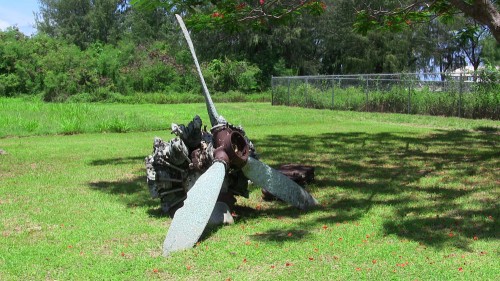
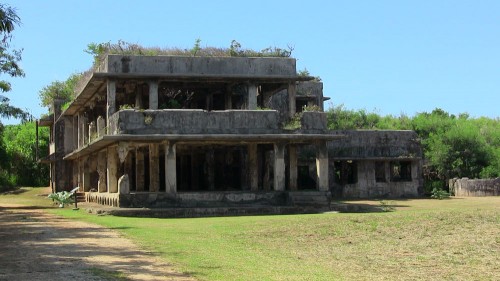

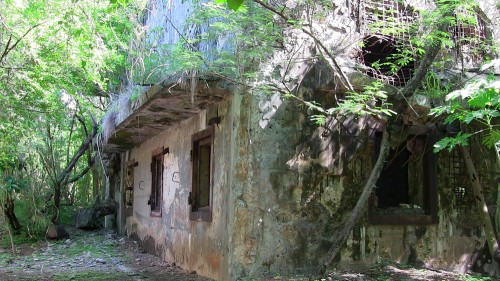
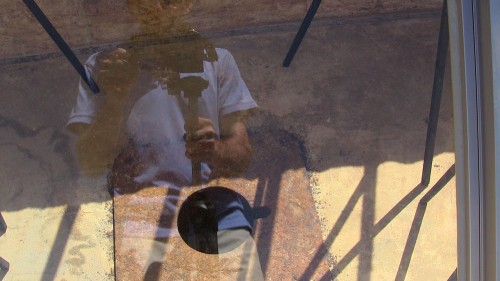
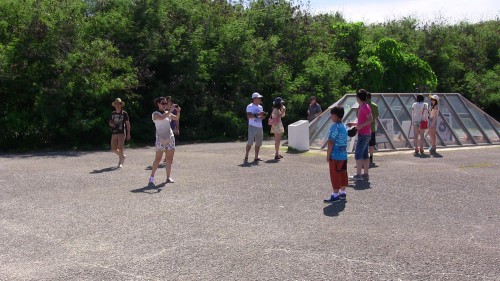

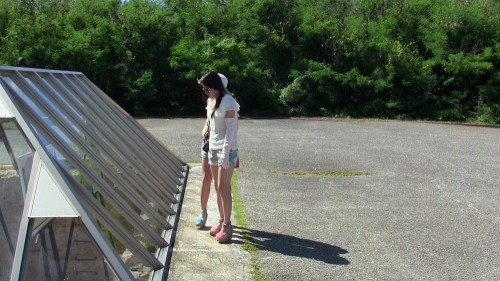

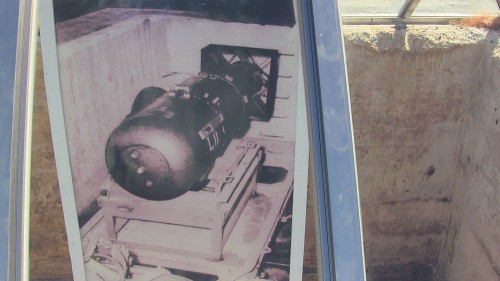
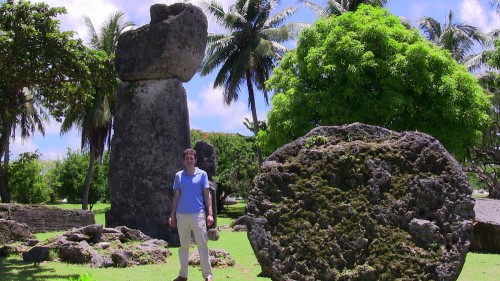
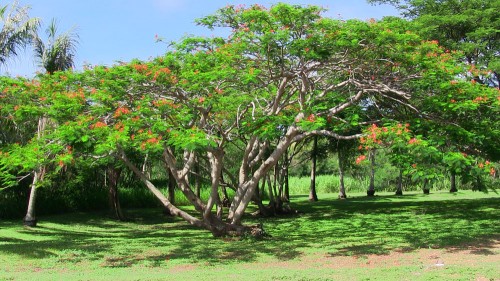


my dad flew out of there on the “sitting pretty” they were shot down in may of 45. all his crew survived. thanks for this site
awesome film I always wanted to go to tinian. thanks for the site
My father was at Tinian in early 1945 as a radarman on the cruiser Vicksburg. I have always wanted to visit the places he did during the war. Your video & pics reinforce my goals.
Not many folks go there from the US, but tons of Japanese go there to gamble at the hotels. My father had orders for Operation Coronet in November 1945. Thanks to the 509th and the A-Bomb there was no invasion, so here I am- another Boomer who is grateful for the Bomb. I made a pilgrimage there in 2005 along with trips to Saipan, Guam and Peleliu. It is truly humbling to see what those men faced to get ashore in 1944…
Here is the clip I made while I was there:
Kert,
At the 3:37 mark of your video, where it shows Fat Man suspended outside the assembly shed, that is my dad standing on the right (wearing shorts, no shirt). I’ve seen this footage on another site that requires payment for a cut of the video. What was your source of this video? Thank you. MPK
Very cool that you were able to identify your dad in the footage. Was he army or one of the Los Alamos gang?
You can find most footage here:
Motion Picture Films and Sound and Video Recordings
The following finding aids include references to NARA’s motion picture films and sound and video recordings and located at the National Archives at College Park. For further information about the motion picture, sound, and video records identified in these finding aids, contact the Special Media Archives Services Divison-Motion Pictures, National Archives at College Park, 8601 Adelphi Road, College Park, MD 20740-6001, telephone 301-837-0526, e-mail: mopix@nara.gov.
Any footage shot by US government employees is generally available to use for free to US citizens, whose taxes paid for the footage. You might have to pay for duplication or transfer services; those are typically what online services are charging for, not the right to use the footage. I suggest you try Lou Reda Productions, contact Adam Reda for screeners of the footage they have transferred for their programs.
Best of luck
He was Army/Air Force.
Thanks much for replying with further details.
I was there in 2005 at the behest of the Tinian government to participate in their 60th Anniversary Commemorative Events. Within an hour of arriving on Tinian, I was able to prove conclusively that the West Loading Pit, what they call the “No. 1 Little Boy Pit” was actually used to load both combat Little Boy and Fat Man bombs. Pit No. 2 was used to load the Pumpkin “Fat Man” test bombs. The island is like a “Time Machine” since so much was just left in place almost exactly like it was back in 1945.
As to its current use, our military has already restored Runway Baker and are landing transport planes during training missions. When I was there again in 2010, our Department of Homeland Security had also shut-off access to Tinian Harbor and their one-and-only catamaran “taxi” used to ferry people between Saipan and Tinian sits inacsesable behind the fence.
I was stationed in Okinawa back in 1981 to 1982 and had the opportunity to go to Tinian for 30 days to start the cleaning of bombs and cleaning of the Run ways. My main Job was Bulk fuel man 8th engineers. I remember when I exited the C 130 the temp was 104 degrees. We supplied fuel for all equipment and at that time the Run way cleaning were not even started yet, but the finding of bombs were. It was a great time for me out there and great History. My friends and I were not with any tour back then just in the Marines doing our Job. We did run into one of the bomb sights and I can’t remember any glass covering the hole where the bombs were how strange. The ocean water was so clear and Natives were friendly. I did go on the run ways but walked due to most had trees and brush growing through the assault. Could not drive the jeep through all that brush. Thanks for the Memories.
Ron!
I find all of this very interesting, and I’m always scouring the internet to learn more. My Grandfather was stationed on Tinian as a Navy Metalsmith. Judging by the buildings in his photos, it is no surprise little is left. Seemed like a lot of wooden structures with corrugated metal roofing. As I understand it a massive Typhoon hit not long after the war ended and wiped out much of what was left.
In 1983 I was in the Marine Corps and a member of the 1st Battalion 6th Marines which at the time was under the command of Lt. Col. Wes Fox, a Medal of Honor recipient. While the Battalion was deployed to Okinawa for 6 mounts, Col. Fox took us several places on training operations, one was to Guam and then on to Tinian. Both of these Islands hold a lot of Marine Corps History and it was a real honor to have visited both. We stayed on Tinian several days and had the opportunity to see a lot of Marine, Japanese and world history. I wish I had more Photos but I do have a few good ones of one of the “bomb loading pits” as it was in 1983.
Something I haven’t seen mentioned anywhere is the fact that at one time, at least one of the loading pits had an Olive Tree, as a symbol of peace, planted in it. You can see in my picture that it is not a palm tree as I’ve seen in some photos. Not sure which one, but Col. Fox is one of the Marines in the Photo, I’m taking the photo. To that point I had never seen a Marine Rifle Battalion be so still and silent. As we stood there and it began to sink in as to where you were and what had taken place there some 40 years earlier, it became a very surreal moment. Looking across the Pacific toward Saipan, you can almost see the landing crafts with Marines getting ready to come ashore and experience the sounds and smell of the battle our Marine brothers fought on Tinian. In fact, we found several areas on the shore of Tinian where there was still a large amount of what is left of rifle/small arms brass, still washing up in the surf (I brought a pocket full of it home).
I remember it being silent moment as we all took turns reading the marker at the Loading Pit, looking at where the pit once was and walking off without any of us ever saying a word, the place and moment said it all.
This was an experience that few people will ever have in their life time and I am very appreciative of having been the recipient of it. The older I have gotten, the more it has meant. If there is anyone interested in seeing the photos of the pit with the Olive Tree and the few others I have of Tinian I would be glad to post them, just let me know where.
I am the Historian of the 505th BG stationed on North Field in 1945. Also had the privilege of visiting Tinian in 2000 for the dedication of the plaque honoring the 188 KIA/MIA airman of the 505th. Would love to see your photos if your would forward to me and I will forward them to my extensive email list. Also why don’t you post them on the 505th Facebook page?
Thanks much.
Nancy Samp
Hi. I tried to find the FB page for the 505th bombardment group on Tinian. No luck. Lots of 505ths though. Can you provide better FB identity? I want to “like” and post a video clip I made while at North Field in 2005 paying my respects.
Thanks!
Kert
https://www.facebook.com/505thBombardmentGroup
Here it is, Kert.
Nancy
Thanks. I posted my clip and have already had a reply from a guy whose dad flew out of there in 29s
kv
WWII history is a lifelong hobby of mine, and Tinian is one of the places near the top of my bucket list. It’s funny how folks find different things to fascinate them (such as the loading pits or the Japanese building ruins). For me, I think it would just be to get a sense of the massiveness of the operation, particularly the lengths of the runways (times 4!). I always imagined what it would be like to be visitor from another time, set up a lawn chair at the end of one of the runways and watch the fully loaded bombers gradually making their way toward you, growing in size, using most of the 8,000 feet to get airborne and then climbing a few feet over you with a deafening roar. One after another after another as they circle the island and begin to form up for their trip to Japan. I viewed a fully restored Superfortress at the New England Air Museum in Windsor Locks, Conn, and it was HUGE! The piston engine/propeller drive would make them seem like giants moving in slow motion compared to today’s jets, which would make it all the cooler. Someday I really hope to get there.
My Dad was stationed on Tinian during the war. He was a tail gunner on a B-29. I’ve often wondered what he experienced on the island. I’m considering a trip to Japan…and thought maybe a side trip to Tinian would work for me. As disappointed as I am that most of the history is gone, i’m still fascinated by the fact that I could possibly walk down a runway that he flew off of….. Thanks so much for the pictures. Any suggestions u may have would be greatly appreciated…… Doug Sirotiak
Hi Doug:
In 2005 I got there from Saipan on a big commercial ferry. I’m not sure that the ferry is still running. Lots of Japanese go there to gamble at the casino/hotel on the southern end of the island so there has to be some way to get over there nowadays. Standing at the end of runway Able or Baker is every bit as chilling as you imagine. By all means go there. Maybe you could stopover on Saipan enroute to Japan and take a day to go over. There is a small air charter company on the Island that flies between there and Saipan. Maybe one of the pilots would fly you over for cheap if you told him why you wanted to go. I got a free ride back to Saipan that way!
Thank you so much, Kert for your response. My Dad died in 1998, and looking back, I so wish I spent kmore time talking to him about the war,but he never wanted to. In fact, a few years before he passed, a B-29 was at a local airport as part of an airshow. I begged him to go with me and tell me about the plane.
He refused, wanting no part of it…and he was VERY adamant about it. My dad NEVER flew after the war, despite having the opportunities. He would drive for 3 days rather than fly. All this tells me is that he probably didnt have the best experiences during the war. He flew numerous missions over Japan,eventually getting shot down and having to bailout over China…and mom said he often re-fought the war at night. We recently held a memorial service for him, where TAPS was played at his grave..as we failed to do it when he died. It was a closure for the family.All of this has roused my interest in tracing his steps thru the war…from Japan and eventually Tinian….I feel I’m being drawn there…
So many of our dads never spoke about the War. I think we kids (hah! I’m 63…) always figured that they had just put it behind them and got on with their lives. Turns out they had BURIED it.
By all means go to Tinian. It is humbling.
Thank you for the pics, video, and information. My dad was based on Tinian at the war’s end. He rarely spoke of his time during WWII but he did talk about seeing the B-29’s constantly flying in and out and of the day the Enola Gay returned knowing something big had just happened.
I am 66 and have visiting Tinian on my bucket list for quite a while. Do most folks take part in a formal tour or visit on their own?
When I went in 2005 there was still a ferry that went to Tinian from Saipan. Here is more recent info. You will definitely be on your own.
https://www.lonelyplanet.com/thorntree/forums/australasia-pacific-pacific-islands-papua-new-guinea/northern-mariana-islands/what-i-wish-i-had-known-about-tinian-before-going
Standing on one of the overgrown runways of North Field and closing your eyes and imagining… that will be worth the trip. I promise.
Kert.. thank you for the link and info.
regards
Bob
I hope you get to go!
I was going through my fathers military files that he had left me, my father passed away in 2003. My father Robert L. Plourd served in the USN in WWII, Korea, and Vietnam. My father was stationed on Tinian with the CASU FIXIN FIGHT’N 44 from 1944 to 1946. I have found black and white photos of the island, taken by my father and his ship mates, during their stay on the island. There are some of Japanese solders, and various buildings. I also have a coffee cup from the 50th Anniversary Reunion 1-3 September 1994 in Kansas City. I am in aw of my father and his military service. For him to be stationed on Tinian when Little Boy and Fat Man were loaded into the B-29s simply astounds me. My father never talked about the island of Tinian, or much of what he did during the war. One of the most interesting items that I found was in his foot locker packed with moth balls. I found a United States Flag that is 48 stars, the flag has some damage to it, could have been shrapnel, or something, however I have no idea where the flag came from, it is not marked in any way. I am researching my fathers military career, and every day I find something more interesting than the day before.
My dad also served on Tinian at just about the same time as yours. How are you able to research your dad’s military service records? I have some of Dad’s paperwork, pics, etc, too….. But it would be interesting for me to know what else there may be. Like you…I am very proud of my Dad’s military service. In fact…just recently we had TAPS played at his grave site…something we never thought to do at his burial. It bothered me for years. Having TAPS played for him brought a lot of closure to the family….especially me. Any info you can help with would really be appreciated…. Thanks…Doug Sirotiak